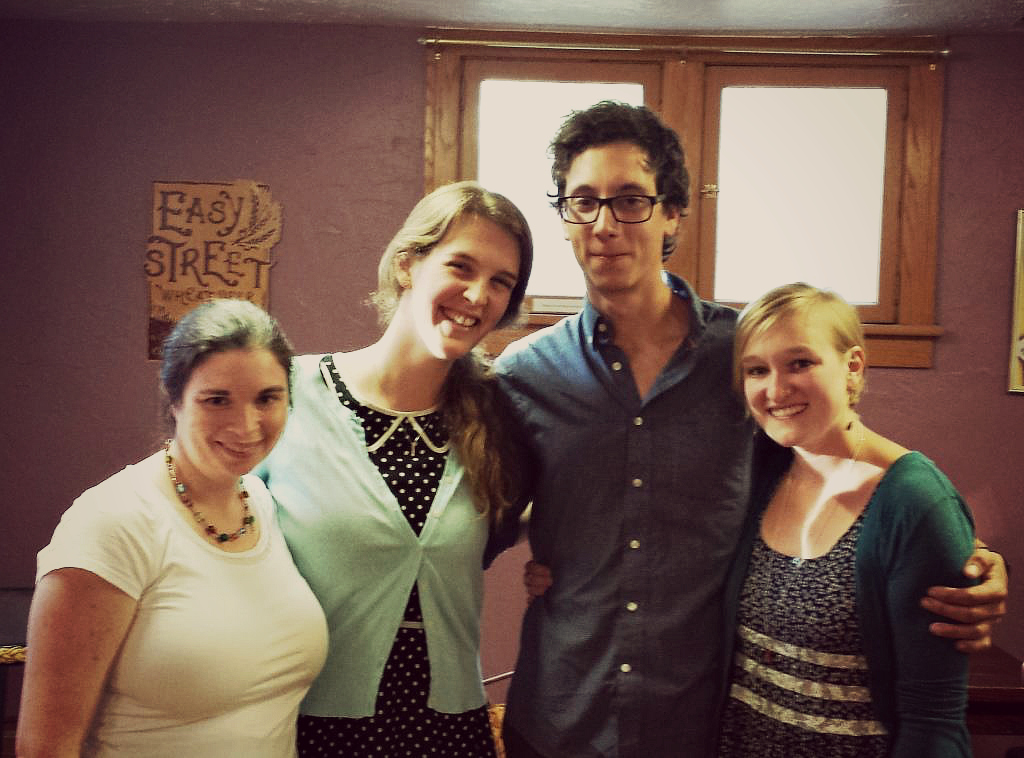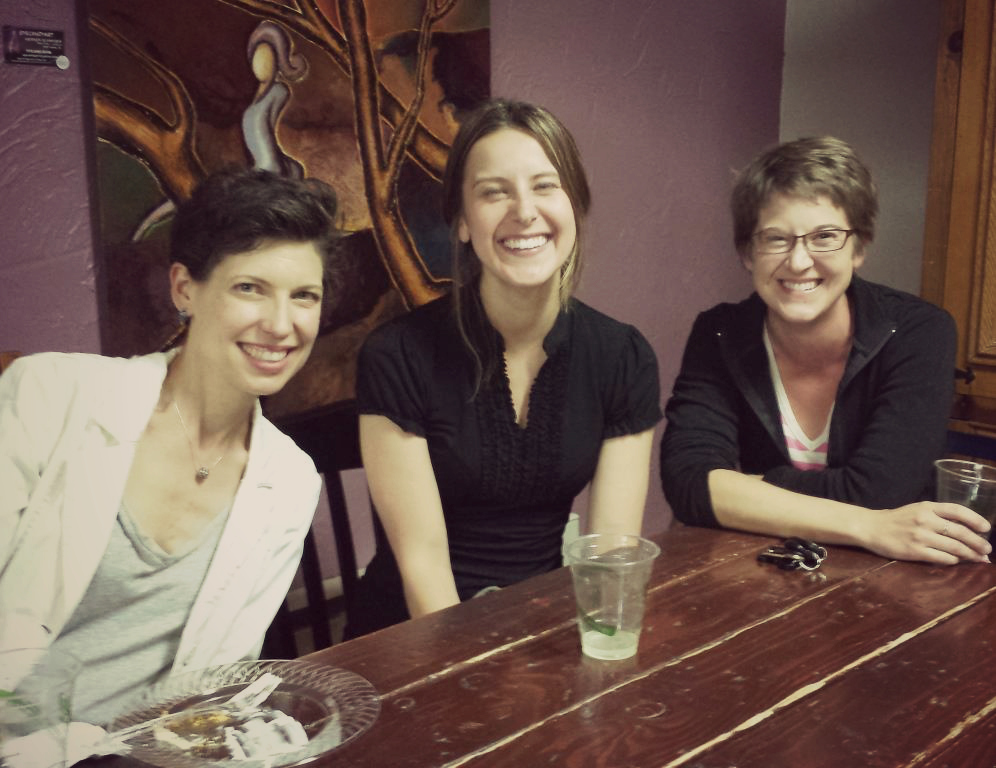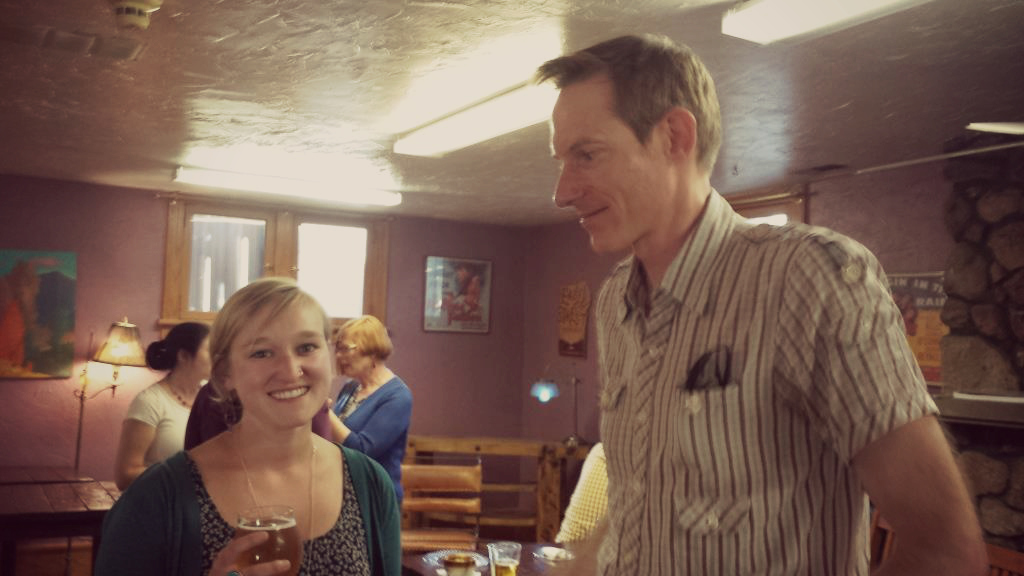
four of the six Literature students who defended or will defend their projects in the academic year 2014-2015
The literature faculty and the department of English recently hosted the Literature MA Showcase, a celebration of literature graduate students who have defended or will be defending their MA projects and earning their MA in 2014-2015. This year, we gathered at the Wild Boar Cafe to hear remarks about their projects, to offer our congratulations, and to enjoy refreshments and spirited conversation. Friends, family, current students in various graduate concentrations, and even a prospective student visiting campus learned about the diverse topics and approaches that literature students have been researching and writing about.




Here are a few examples of projects completed by Literature students this year, from Kim Daggett, Karen Montgomery Moore, and Olivia Tracy, who all attended the event, and one from Amy Moore, who defended in Fall 2014 but wasn’t able to be at the showcase.
Kim Daggett’s project: “Moving Landscape: The Narrative of the Poudre River Trail through Time, Space, and Place.” She describes it this way:
In my paper I examine how the Poudre River Trail forms a narrative arc through landscape that influences the way we think about, understand, and interact with space. In my paper I examine trail design and how we can see these design choices as embedding space with certain cultural and social ideologies about landscape that are then translated to the trail walker. I also want to show how space becomes place through time, transforming into a site of personal and collective meaning. In order to illustrate this transition from space to place I decided to root my paper in a landscape that I am deeply familiar with, the Poudre River Trail. I used the frame of the Poudre Trail to describe my own experience of space becoming place and interwove moments of memoir to illustrate this transition. I also incorporated other’s stories to illustrate how the Poudre River Trail is a place of collective memories and narratives, highlighting that the story of the Trail cannot be told by only one person. My hope is that my project will encourage people to think differently about how they value landscape and space. I want to push people to see beyond landscapes as mere space and understand that almost anywhere has the power to become place.

Amy Moore’s project: “‘One little window’: Lamkin and the Horror of the Real.”
This paper explores the aspects of horror at work in the Scottish folk ballad Lamkin and how it relates to modern horror cinema using cinematic examples such as The Purge and Insidious. The research of Mikel J. Koven and Adam Ganz is used to examine the relationship between folklore and film in terms of both horror genre conventions and stylistic similarities. Folklorist John Widdowson’s research on bogey figures enables the connection of the titular character of Lamkin to the frightening figures that appear in both oral storytelling and modern horror films as well as to Sigmund Freud’s concepts of the uncanny and the return of the repressed as demonstrated in Freud’s own analysis of a bogey figure called the Sand-man from the E.T.A. Hoffmann story of the same name. Perhaps the most important piece of research connecting Lamkin to both bogey figures and the horror genre is folklorist John DeWitt Niles’s article “Lamkin: The Motivation of Horror,” which traces the ballad’s origins to the name-of the-helper tale-type, the master-builder legends, European devil lore, and foundation sacrifice. This paper expands on Niles’s argument, taking his claims further to show that, as the name of his article implies, Lamkin should indeed be classified as “horror.” In addition to Freud, this paper uses the work of psychoanalytic theorists Jacques Lacan, and Slavoj Žižek as a theoretical framework, including Lacan’s idea of the neighbor as inhuman “thing” and Žižek’s reworking of the Lacanian concept of the Real.
Karen Montgomery Moore’s project: “Affect, Anxiety, and the Abject Corpse in A Study in Scarlet.”
In my paper, I use theorists including Foucault, Julia Kristeva, and Sara Ahmed to interrogate the murder victim’s corpse in A Study in Scarlet. Narratively, the murder victim’s corpse is not merely the object of detection or forensic examination in A Study in Scarlet, but it is also the subject of the mystery, a centrality that mirrors how the victim’s body becomes crucial to Victorian England police investigations. Due to the corpse’s abject nature and uncertain meaning, it becomes a “contested site”, or occupies a liminal space onto which multiple societal anxieties are displaced. In seeking answers about the murder, characters work to determine the particular meaning of the corpse and reduce it to an object so as to diffuse its significant affective influence. Holmes positions himself toward the abject corpse and embraces its unclear meaning, whereas Watson becomes subject to it and the ever-present criminal threat to his person it represents. In rupturing the subject/object distinction, the corpse reveals the potential inability of authority figures to discipline criminal activities into the clear confines of the law. Though the mystery is solved, the abject presence of the corpse reveals social concerns about violent crime and the effectiveness of the police, concerns that cannot be so easily hidden again.
Olivia Tracy’s project: “Commerce and Commodity: ‘Imperial Madness’ and Desire for the Other in Angela Carter”
My project analyzes two works by Angela Carter: her radio play, “Come Unto These Yellow Sands,” (1979) an ‘artificial biography’ about the life and mental illness of Victorian painter Richard Dadd, and her short story “Overture and Incidental Music for A Midsummer Night’s Dream” (1985), an “overture,” or prefatory material, to the events of A Midsummer Night’s Dream, detailing the origins of the debate between Titania and Oberon as told from the point of view of the object and cause of the debate, the Indian Boy, whom Carter reimagines as “The Golden Herm.” Through close readings of both figures and landscape, I argue that Carter is utilizing a “self-conscious Orientalism” in these works, a term devised to encapsulate how Carter uses multiple perspective and pastiche to reveal the British imperial wish-fulfillment of commodification and exoticism of the Other. She does this, I argue, to ultimately reveal the “imperial madness” at the center of both of these cultural texts and the way in which this continued commodification of the Other is both a cause and result of this madness. Through the use of self-conscious Orientalism to reveal this imperial madness, Carter foregrounds and critiques the materialist, commercial aspects of the imperial capitalist project at the heart of the two original narratives and, ultimately, at the heart of the Thatcher government of Carter’s own period.
Congratulations to all! We are so proud.